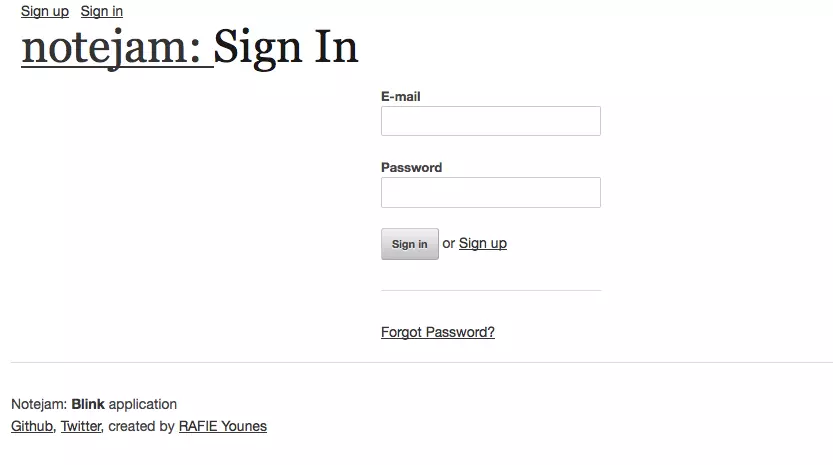Can PHP Be Even Faster? Light-Speed with the Blink Framework
Blink: A High-Performance PHP Framework
You've likely heard of Lumen, Silex, and Slim. Now, meet Blink, a new PHP framework designed for high-performance applications demanding significant server resources. This article explores Blink's capabilities and demonstrates its use through a sample "Notejam" application.

Blink leverages the Swoole PHP extension to achieve its performance goals. Let's dive into the details.
Key Features:
- Performance Optimization: Blink utilizes Swoole for enhanced performance, making it ideal for resource-intensive applications.
- Installation: Installation is via Composer. Note: The current Swoole version requires PHP 5 (not compatible with PHP 7).
- Flexibility: While lacking default templating and database management, Blink seamlessly integrates with popular choices like Twig and Eloquent.
- Notejam Application Example: This article guides you through building a Notejam app showcasing user authentication, session management, and CRUD operations for notes and pads.
- Resource Efficiency: The combined power of Blink and Swoole minimizes server load by keeping application resources active throughout the application's lifecycle.
- Community Driven: As a relatively new framework, Blink welcomes community contributions to documentation and feature development.
Swoole Extension Installation:
Blink's performance relies on the Swoole extension. This guide uses PEAR on Ubuntu 14.04 with a LAMP setup (using Vaprobash; see the project's Vagrantfile for details). (Note: Swoole's current incompatibility with PHP 7 is a factor in this setup choice.)
sudo apt-get update sudo apt-get install php-pear php5-dev libcurl3-openssl-dev sudo pecl install swoole
After installation, remember to add extension=swoole.so to your php.ini file. Verify the extension's loading with:
php -m | grep 'swoole'
(Current Swoole version: 1.7.22-alpha, incompatible with PHP 7; future versions aim to address this.)
Installing Blink:
Use Composer:
composer create-project --prefer-dist blink/seed
Start the server:
php blink server serve
Access the application at http://localhost:7788 (or adjust the port as described below).

Configuration:
While Blink doesn't offer command-line port specification, you can modify the port in src/config/server.php:
<?php return [
'class' => '\blink\server\SwServer',
'bootstrap' => require __DIR__ . '/../bootstrap.php',
'host' => '0.0.0.0',
'port' => 8080,
];Remember to restart the server after making changes. The config directory also houses application and service configurations.
Building the Notejam App:
The Notejam app (available on Github) includes:
- Sign-in (with password reset)
- Sign-up
- Account settings (password change)
- Note and pad management
Integrating Twig (Templating Engine):
Blink doesn't include a default templating engine; we'll use Twig. Modify src/bootstrap.php and add src/bindings.php:
sudo apt-get update sudo apt-get install php-pear php5-dev libcurl3-openssl-dev sudo pecl install swoole
php -m | grep 'swoole'
Integrating Eloquent (Database Management):
For database interaction (users, notes, pads), we'll use Eloquent. Install via Composer:
composer create-project --prefer-dist blink/seed
Then, configure Eloquent in src/bindings.php:
php blink server serve
(Database migrations are handled via src/console/MigrateCommand.php and src/config/app.php.)
Routing, Controllers, and Views:
Routes are defined in src/http/routes.php. Controllers reside in src/http/controllers. Views use Twig templates. The article provides detailed examples of these components for the Notejam app's functionality (sign-up, sign-in, settings, note management). Middleware is used for authentication and authorization.
Sessions and Cookies:
Blink doesn't automatically handle PHP sessions; manual management (using the request object) is necessary.
Conclusion:
Blink, while still in early development, offers a compelling high-performance alternative. The community is encouraged to contribute to its growth and improvement.





The provided FAQs are already comprehensive and well-structured. No further modifications are needed.
The above is the detailed content of Can PHP Be Even Faster? Light-Speed with the Blink Framework. For more information, please follow other related articles on the PHP Chinese website!

Hot AI Tools

Undresser.AI Undress
AI-powered app for creating realistic nude photos

AI Clothes Remover
Online AI tool for removing clothes from photos.

Undress AI Tool
Undress images for free

Clothoff.io
AI clothes remover

Video Face Swap
Swap faces in any video effortlessly with our completely free AI face swap tool!

Hot Article

Hot Tools

Notepad++7.3.1
Easy-to-use and free code editor

SublimeText3 Chinese version
Chinese version, very easy to use

Zend Studio 13.0.1
Powerful PHP integrated development environment

Dreamweaver CS6
Visual web development tools

SublimeText3 Mac version
God-level code editing software (SublimeText3)

Hot Topics
 1673
1673
 14
14
 1429
1429
 52
52
 1333
1333
 25
25
 1278
1278
 29
29
 1257
1257
 24
24
 Explain secure password hashing in PHP (e.g., password_hash, password_verify). Why not use MD5 or SHA1?
Apr 17, 2025 am 12:06 AM
Explain secure password hashing in PHP (e.g., password_hash, password_verify). Why not use MD5 or SHA1?
Apr 17, 2025 am 12:06 AM
In PHP, password_hash and password_verify functions should be used to implement secure password hashing, and MD5 or SHA1 should not be used. 1) password_hash generates a hash containing salt values to enhance security. 2) Password_verify verify password and ensure security by comparing hash values. 3) MD5 and SHA1 are vulnerable and lack salt values, and are not suitable for modern password security.
 How does PHP type hinting work, including scalar types, return types, union types, and nullable types?
Apr 17, 2025 am 12:25 AM
How does PHP type hinting work, including scalar types, return types, union types, and nullable types?
Apr 17, 2025 am 12:25 AM
PHP type prompts to improve code quality and readability. 1) Scalar type tips: Since PHP7.0, basic data types are allowed to be specified in function parameters, such as int, float, etc. 2) Return type prompt: Ensure the consistency of the function return value type. 3) Union type prompt: Since PHP8.0, multiple types are allowed to be specified in function parameters or return values. 4) Nullable type prompt: Allows to include null values and handle functions that may return null values.
 PHP and Python: Different Paradigms Explained
Apr 18, 2025 am 12:26 AM
PHP and Python: Different Paradigms Explained
Apr 18, 2025 am 12:26 AM
PHP is mainly procedural programming, but also supports object-oriented programming (OOP); Python supports a variety of paradigms, including OOP, functional and procedural programming. PHP is suitable for web development, and Python is suitable for a variety of applications such as data analysis and machine learning.
 PHP and Python: Code Examples and Comparison
Apr 15, 2025 am 12:07 AM
PHP and Python: Code Examples and Comparison
Apr 15, 2025 am 12:07 AM
PHP and Python have their own advantages and disadvantages, and the choice depends on project needs and personal preferences. 1.PHP is suitable for rapid development and maintenance of large-scale web applications. 2. Python dominates the field of data science and machine learning.
 How do you prevent SQL Injection in PHP? (Prepared statements, PDO)
Apr 15, 2025 am 12:15 AM
How do you prevent SQL Injection in PHP? (Prepared statements, PDO)
Apr 15, 2025 am 12:15 AM
Using preprocessing statements and PDO in PHP can effectively prevent SQL injection attacks. 1) Use PDO to connect to the database and set the error mode. 2) Create preprocessing statements through the prepare method and pass data using placeholders and execute methods. 3) Process query results and ensure the security and performance of the code.
 PHP: Handling Databases and Server-Side Logic
Apr 15, 2025 am 12:15 AM
PHP: Handling Databases and Server-Side Logic
Apr 15, 2025 am 12:15 AM
PHP uses MySQLi and PDO extensions to interact in database operations and server-side logic processing, and processes server-side logic through functions such as session management. 1) Use MySQLi or PDO to connect to the database and execute SQL queries. 2) Handle HTTP requests and user status through session management and other functions. 3) Use transactions to ensure the atomicity of database operations. 4) Prevent SQL injection, use exception handling and closing connections for debugging. 5) Optimize performance through indexing and cache, write highly readable code and perform error handling.
 PHP's Purpose: Building Dynamic Websites
Apr 15, 2025 am 12:18 AM
PHP's Purpose: Building Dynamic Websites
Apr 15, 2025 am 12:18 AM
PHP is used to build dynamic websites, and its core functions include: 1. Generate dynamic content and generate web pages in real time by connecting with the database; 2. Process user interaction and form submissions, verify inputs and respond to operations; 3. Manage sessions and user authentication to provide a personalized experience; 4. Optimize performance and follow best practices to improve website efficiency and security.
 Choosing Between PHP and Python: A Guide
Apr 18, 2025 am 12:24 AM
Choosing Between PHP and Python: A Guide
Apr 18, 2025 am 12:24 AM
PHP is suitable for web development and rapid prototyping, and Python is suitable for data science and machine learning. 1.PHP is used for dynamic web development, with simple syntax and suitable for rapid development. 2. Python has concise syntax, is suitable for multiple fields, and has a strong library ecosystem.




